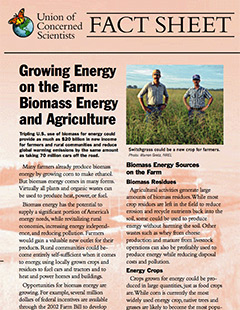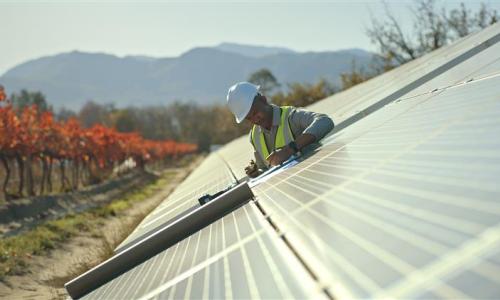Many farmers already produce biomass energy by growing corn to make ethanol. But biomass energy comes in many forms. Virtually all plants and organic wastes can be used to produce heat, power, or fuel.
Biomass energy has the potential to supply a significant portion of the country's energy needs, while revitalizing rural economies, increasing energy independence, and reducing pollution. Farmers would gain a valuable new outlet for their products. Rural communities could become entirely self-sufficient when it comes to energy, using locally grown crops and residues to fuel cars and tractors and to heat and power homes and buildings.
Opportunities for biomass energy are growing. For example, several million dollars of federal incentives are available through the 2002 Farm Bill to develop advanced technologies and crops to produce energy, chemicals, and other products from biomass. A number of states also provide incentives for biomass energy.
Biomass energy sources on the farm
- Biomass Residues: Agricultural activities generate large amounts of biomass residues. While most crop residues are left in the field to reduce erosion and recycle nutrients back into the soil, some could be used to produce energy without harming the soil. Other wastes such as whey from cheese production and manure from livestock operations can also be profitably used to produce energy while reducing disposal costs and pollution.
- Energy Crops: Crops grown for energy could be produced in large quantities, just as food crops are. While corn is currently the most widely used energy crop, native trees and grasses are likely to become the most popular in the future. These perennial crops require less maintenance and fewer inputs than do annual row crops, so they are cheaper and more sustainable to produce.
- Grasses: Switchgrass appears to be the most promising herbaceous energy crop. It produces high yields and can be harvested annually for several years before replanting. Other native varieties that grow quickly, such as big bluestem, reed canarygrass, and wheat grass, could also be profitable.
- Trees: Some fast-growing trees make excellent energy crops, since they grow back repeatedly after being cut off close to the ground. These short-rotation woody crops can grow to 40 feet in less than eight years and can be harvested for 10 to 20 years before replanting. In cool, wet regions, the best choices are poplar and willow. In warmer areas, sycamore, sweetgum, and cottonwood are best.
- Oil plants: Oil from plants such as soybeans and sunflowers can be used to make fuel. Like corn, however, these plants require more intensive management than other energy crops.
Protecting the land
With thoughtful practice and management, perennial energy crops can improve the soil quality of land that has been overused for annual row crops. The deep roots of energy crops enhance the structure of the soil and increase its organic content. Since tilling occurs infrequently, the soil suffers little physical damage from machinery. One study estimates that converting a corn farm of average size to switchgrass could save 66 truckloads of soil from erosion each year.
Perennial energy crops need considerably less fertilizer, pesticide, herbicide, and fungicide than annual row crops. Reduced chemical use helps protect ground and surface water from poisons and excessive aquatic plant growth. Furthermore, deep-rooted energy crops can serve as filters to protect waterways from chemical runoff from other fields and prevent sedimentation caused by erosion.
Finally, perennial energy crops can create more diverse habitats than annual row crops, attracting a wider variety of species such as birds, pollinators, and other beneficial insects, and supporting larger populations. Furthermore, the long harvest window for energy crops enables farmers to avoid nesting or breeding seasons.
Converting biomass to energy
Most biomass is converted to energy the same way it always has been—by burning it. The heat can be used directly for heating buildings, crop drying, dairy operations, and industrial processes. It can also be used to produce steam and generate electricity. For example, many electric generators and businesses burn biomass by itself or with other fuels in conventional power plants.
Biomass can also be converted into liquids or gases to produce electricity or transportation fuels. Ethanol is typically produced through fermentation and distillation, in a process much like that used to make beer. Soybean and canola oils can be chemically converted into a liquid fuel called biodiesel. These fuels can be used in conventional engines with little, if any, modification.
Biomass can be converted into a gas by heating it under pressure and without oxygen in a "gasifier." Manure too can be converted using a digester. The gas can then be burned to produce heat, steam, or electricity.
Other biogas applications are still in development, but show great potential. One promising technology is direct combustion in an advanced gas turbine to run a generator and produce electricity. This process is twice as efficient as simply burning raw biomass to produce electricity from steam. Researchers are also developing small, high-speed generators to run on biogas. These "microturbines" have no more than three moving parts and generate as little as 30 kilowatts, which could power a medium-sized farm. Several companies are also considering converting gasified biomass into ethanol as a less expensive alternative to fermentation.
Alternatively, biogas can be processed into hydrogen or methanol, which can then be chemically converted to electricity in a highly efficient fuel cell. Fuel cells can be large enough to power an entire farm or small enough to power a car or tractor.
An innovative experiment in Missouri provides one example of the possibilities. Corn is used to produce ethanol, and the waste from the process is fed to cows for dairy production. Cow manure fertilizes the corn and is also run through a digester to produce biogas. A fuel cell efficiently converts the biogas into electricity to run the operation. The end products are ethanol, electricity, and milk. All the waste products are used within the project to lower costs.
Potential
Biomass currently provides about two percent of the nation's electricity, one percent of the fuel used in cars and trucks, and some of the heat and steam used by homes and businesses. With more energy crops and better conversion technology, it could gain a much larger portion of the market. Energy crops and crop residues could provide 14 percent of U.S. electricity use or 13 percent of the nation's motor fuel.
An Oak Ridge National Laboratory (ORNL) study found that farmers could grow 188 million dry tons of switchgrass on 42 million acres of cropland in the United States at a price of less than $50 per dry ton delivered (see map below). This level of production would increase total U.S. net farm income by nearly $6 billion. ORNL also estimates that about 150 million dry tons of corn stover and wheat straw are available annually in the United States at the same price, which could increase farm income by another $2 billion. This assumes about 40 percent of the total residue is collected and the rest is left to maintain soil quality.
Assumes energy crop production is limited to areas where these crops can be produced without irrigation and where sufficient research has been done to provide reliable information on yields and management requirements. Thus, other areas of the United States may also be suitable for growing energy crops.
Source: Daniel G. De La Torre Ugarte, Marie E. Walsh, Hosein Shapouri, and Stephen P. Slinsky. The Economic Impacts of Bioenergy Crop Production in U.S. Agriculture, 1999. Online at bioenergy.ornl.gov/papers/wagin/index.html.




